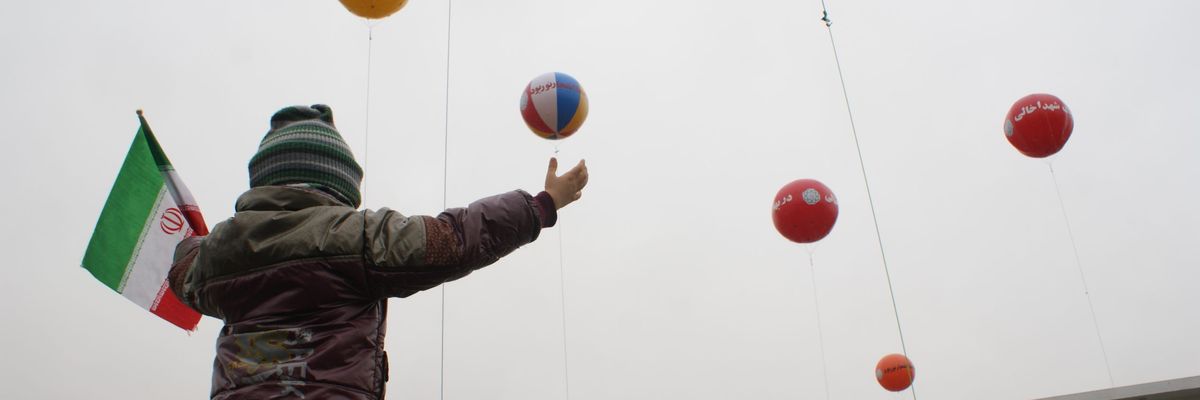Iran turns 41 on Tuesday, give or take a few thousand years.
As part of the official commemorations for the anniversary of the 1979 Revolution, or what is known in Iran as "Ten Days of Dawn" (Dahe-ye Fajr), state television broadcasts archival footage from that period. The scenes and images are unimaginable the rest of the year. There are men with Western ties and women without Islamic hijabs. Secular housewives march in the streets alongside hezbollahi students. President Jimmy Carter toasts the Iranian monarch in Tehran, and Ayatollah Khomeini meets with American journalists in France. Every year, the hapless shah comes back to life, resurrected by state media only to be chased out of the country once again, while on another channel Khomeini descends from the sky and into our living rooms on the wings of an Air France passenger plane, escorted out of exile, out of the wilderness, and back into Iran.
The footage is a reminder that revolutions can produce strange combinations, that the collective memory of those days will forever come in passé hues and sepia tones. Will there ever again in history be revolutionaries decked out in wide-collar three-piece suits and feathered hair?
Iranians watch this history replayed every year on television, but the Revolution is not about history. One thing that must be understood about Iran, about living there, is that the Revolution is never officially discussed as a finished event. Revolution is transitive, a work still in progress. A reporter asked a young man on the street about his opinion of the Revolution on the occasion of its thirtieth anniversary. The man replied that he wished to be around in 90 years to see the Revolution at 120. One hundred twenty.
There is purpose to this. Revelation comes but once, be it on the ancient plains of Karbala or the winter streets of Tehran four decades ago. But redemption requires rehearsal, when the faithful regularly reprise the moment of grace. Like the mourning rites of Ashura, the revolution is a story to be retold, to be reenacted. Salvation cannot be achieved alone, sitting in the confessional or in front of the television. Blessedness must be en masse, and it must be public. And so every year Iran spools the footage back to 1979, and over 10 days the state leads society in shared ritual.
There is a danger to this, to the public’s exposure to the grammar and habits of revolt. The state organizes the schedule, but it cannot control the meaning that its people attach to the days. Television shows the angry speeches denouncing the West, but out in the crowd the atmosphere is festive. After so many years, the twenty-second of Bahman has become a carnival, more than a political rally. You are just as likely to run into bundled families out for a stroll as you are to find militant basijis marching in formation. The streets fill with vendors selling food, and all along the parade route are the balloon sellers, slowly floating through the crowd wrapped in globes of all shapes and colors. Winnie the Pooh makes an appearance, as does Mickey Mouse, pausing to distribute hugs and photos with the many children gathered there.
In a 2010 interview, recorded in the final days of the Green Movement, less than a year after the fraudulent reelection of Mahmoud Ahmadinejad, former president Mohammad Khatami likened the 1979 Revolution to a train in motion. Defending the Green Movement against accusations of treason, Khatami supported the opposition’s right to gather peacefully at the annual rahpaymani (security forces were rumored to be preparing for a violent crackdown). “Those who groundlessly accuse protesters of subversion,” he warned, “are voluntarily or involuntarily derailing the Revolution from its correct track, and they call into question the principles of the Revolution.”
As Khatami’s words suggest, the meaning of the revolution does not belong to one person or group. Rather, the overthrow of the shah in 1979, like the 2009 demonstrations or the widescale protests that gripped the country at the end of 2019, is part of a public and ongoing struggle for democracy in Iran that reaches back over a century.
What remains compelling about that struggle, about this revolution, is how just how disunited its stalwarts remain. Starting tomorrow Iran turns to the upcoming parliamentary elections, slated for February 21. As Rohallah Faghihi of Al-Monitor reports, even now, with Iran on a war footing following Soleimaini's assassination, and with the playing field cleared of reformists as well as establishment figures such as Ali Motahhari by the Guardian Council, Iran’s ascendant hardline factions have been unable to coalesce around a single ticket and platform. Even for these self-proclaimed guardians of Khomeini’s vision and line, the meaning of 1979 contains multitudes, clouded by personal ambition.
In Tehran the crowds converge on Maidan-e Azadi, Freedom Square, where millions once gathered to witness the final stages of the 1979 Revolution, and where they joined together again in 2009 to demand that their votes be counted. It is where Iranians will gather the next time there is a next time. Where there is injustice, Iranians are told, protest. So, it should come as no surprise that the holidays, practices, slogans, and spaces that constitute the Islamic Republic of Iran provide its citizens with a ready arsenal to use against a state that continues to repeat the mistakes of the regime it overthrew four decades ago and to deny the democratic future promised more than 100 years ago by Iran’s first revolution, the Constitutional Revolution.
From the old liturgy new verses will be fashioned. They march, they protest, these many citizens, because they too seek redemption, for themselves and for their revolution, a revolution not yet over but very much a work still in progress.
A version of this article originally appeared on LobeLog.














